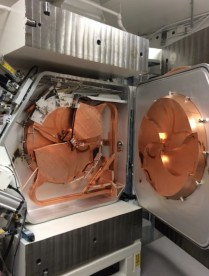Associated Cores
Research in Radiology relies on state-of-the-art technology and expertise to optimize the performance of such equipment, provide quality control, and generate robust research data. Our cores offer services by modern instruments operated by highly trained Radiology personnel.
Advanced Imaging Research Center
The AIRC is a collaboration between UT Southwestern Medical Center and other North Texas institutions to further research in magnetic resonance imaging (MRI) and magnetic resonance spectroscopy (MRS), and translation of discoveries into clinical practice. The Center's research seeks to advance basic understanding, diagnostic techniques, and treatments for a wide range of diseases, including cancer, diabetes, obesity, Alzheimer's disease, schizophrenia, depression, autism, attention-deficit hyperactive disorder (ADHD), and diseases of the heart, lung, and liver.
Cyclotron & Radiochemistry

The Cyclotron and Radiochemistry Program is a UT Southwestern Medical Center-wide effort to develop the full capability of nuclear imaging, namely radioisotope-based imaging, for noninvasive assessment of physiological processes and abnormalities in animal models and in humans.
With a biomedical cyclotron and the capability to synthesize a variety of biomedical radioisotopes, this program leverages the cutting-edge technology of positron-emission tomography (PET) to enable discoveries that span multiple areas of medicine and physiology.
Visit the Cyclotron and Radiochemistry Program's website.
Small Animal Imaging Resource (SAIR)
- Facilitates small animal imaging using multiple modalities including depth resolved or planar optical imaging (fluorescence (FLI), bioluminescence (BLI) and chemiluminescence (CLI)), MRI, ultrasound, photoacoustic tomography, PET/CT, SPECT/CT and planar scintigraphy
- Experienced investigators and technical staff capable of undertaking imaging and assisting in data interpretation are associated with the Resource and provide consultation and assist with analysis of studies
- Infrastructure for animal handling (e.g., anesthesia, infusion, monitoring vital signs). These high-end imaging instruments would be beyond the budget of most research teams and without the Resource, imaging would be unavailable to most investigators
- SAIR leaders and members of the Technical Advisory Committee can advise investigators on experimental planning (optimal experimental approaches, image manipulation, and statistical analysis, coordinating with Institutional Animal Care and Use Committee, and Environmental Health and Safety), implementing investigations (access to instruments and scheduling experiments), data analysis and validation and data archiving.
- These experts can assist with proof of principle investigations, such as pulse programming and implementation for novel MRI experiments, design and acquisition or building of MR coils, choice of reporter molecules and /or genes, radiolabeling procedures and synthesis of ligands. Once experimental protocols have been established, routine investigations will be performed on a cost recovery basis by dedicated skilled technicians.
- SAIR is an institutional facility that promotes and facilitates small animal imaging related to models of human disease
- Currently administered jointly by the Advanced Imaging Research Center (AIRC) and the Department of Radiology
- Small Animal MR Scanner
- The Aspect 1T Desktop is a small animal MR scanner with a relatively small footprint that can be easily housed in animal research facilities. The primary purpose of this 1T MR scanner is to facilitate small animal imaging research within the Department of Radiology and collaborating departments. This includes sequential imaging of small animals such as mice and rats, without sacrificing them, for longitudinal monitoring of either disease progression or therapy response. Being sited next to the small animal PET/CT and SPECT/CT scanners, this allows superposition of images for multimodality analysis.
Visit the Small Animal Imaging Resource's website.
Translational Molecular Imaging Core (TMIC)
Our cyclotron and radiochemistry facility is approved for CGMP production of PET radiopharmaceuticals for human use.
- The facility includes a GE PETtrace 880 cyclotron and ancillary instruments
- Currently capable of producing 6 radioisotopes and >30 radiotracers in addition to the FDA-approved tracers
- A regulatory office in the Department of Radiology facilitates Investigational New Drug (IND) and Abbreviated New Drug Applications (ANDA) approval of radiotracers.
A GE Discovery IQ five ring PET/CT dedicated to research is available on the NE2 building, in close proximity to our cyclotron facility. This state-of-the-art digital time-of-flight (TOF) PET/CT scanner provides a 26 cm axial field of view with the highest noise equivalent count rate (NECR) of the commercially available PET/CT scanners and high NEMA sensitivity (22cps/kBq2). The five-ring system facilitates faster anatomic coverage for whole body PET/CT studies. It has both respiratory and cardiac gating capabilities. A dedicated software package (Dynamic Vue) for quantitative analysis of PET data, including 4D PET datasets, is available.
The Siemens Inveon PET/CT Multimodality System (NE3.116) is a small animal PET/CT imaging scanner built on the Siemens Inveon acquisition architecture, which fully integrates PET and CT into a common data acquisition system for automatic transition between modes and seamless coordination of CT and PET data acquisition
- Development and implementation of imaging protocols in a range of disease models (e.g., cancer, diabetes, metabolism, cardiotoxicity, neurodegenerative diseases, etc.)
- Validation of novel imaging probe development, which ranges from small organic molecules to macromolecules including proteins and nanoparticles
